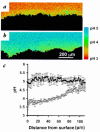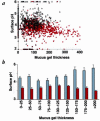Dynamic regulation of gastric surface pH by luminal pH
- PMID: 10074477
- PMCID: PMC408122
- DOI: 10.1172/JCI5217
Dynamic regulation of gastric surface pH by luminal pH
Abstract
In vivo confocal imaging of the mucosal surface of rat stomach was used to measure pH noninvasively under the mucus gel layer while simultaneously imaging mucus gel thickness and tissue architecture. When tissue was superfused at pH 3, the 25 microm adjacent to the epithelial surface was relatively alkaline (pH 4.1 +/- 0.1), and surface alkalinity was enhanced by topical dimethyl prostaglandin E2 (pH 4.8 +/- 0.2). Luminal pH was changed from pH 3 to pH 5 to mimic the fasted-to-fed transition in intragastric pH in rats. Under pH 5 superfusion, surface pH was relatively acidic (pH 4.2 +/- 0.2). This surface acidity was enhanced by pentagastrin (pH 3.5 +/- 0.2) and eliminated by omeprazole, implicating parietal cell H,K-ATPase as the dominant regulator of surface pH under pH 5 superfusion. With either pH 5 or pH 3 superfusion (a) gastric pit lumens had the most divergent pH from luminal superfusates; (b) qualitatively similar results were observed with and without superfusion flow; (c) local mucus gel thickness was a poor predictor of surface pH values; and (d) no channels carrying primary gastric gland fluid through the mucus were observed. The model of gastric defense that includes an alkaline mucus gel and viscous fingering of secreted acid through the mucus may be appropriate at the intragastric pH of the fasted, but not fed, animal.
Figures








Similar articles
-
Hydrogen ion concentration in the mucus layer on top of acid-stimulated and -inhibited rat gastric mucosa.Gastroenterology. 1994 Jul;107(1):180-8. doi: 10.1016/0016-5085(94)90075-2. Gastroenterology. 1994. PMID: 8020660
-
Central vagal activation increases mucus gel thickness and surface cell intracellular pH in rat stomach.Gastroenterology. 1997 Feb;112(2):409-17. doi: 10.1053/gast.1997.v112.pm9024294. Gastroenterology. 1997. PMID: 9024294
-
Pentagastrin enhances gastric mucosal defenses in vivo: luminal acid-dependent and independent effects.Am J Physiol. 1994 Jul;267(1 Pt 1):G94-104. doi: 10.1152/ajpgi.1994.267.1.G94. Am J Physiol. 1994. PMID: 8048536
-
Acid-sensing pathways in rat gastrointestinal mucosa.J Gastroenterol. 2002 Nov;37 Suppl 14:133-8. doi: 10.1007/BF03326432. J Gastroenterol. 2002. PMID: 12572881 Review.
-
Gastroduodenal mucosal protection.Physiol Rev. 1993 Oct;73(4):823-57. doi: 10.1152/physrev.1993.73.4.823. Physiol Rev. 1993. PMID: 8415927 Review.
Cited by
-
Coupled amino acid deamidase-transport systems essential for Helicobacter pylori colonization.Infect Immun. 2010 Jun;78(6):2782-92. doi: 10.1128/IAI.00149-10. Epub 2010 Apr 5. Infect Immun. 2010. PMID: 20368342 Free PMC article.
-
Absorption of short-chain fatty acids, sodium and water from the forestomach of camels.J Comp Physiol B. 2007 Aug;177(6):631-40. doi: 10.1007/s00360-007-0161-8. Epub 2007 Apr 12. J Comp Physiol B. 2007. PMID: 17429653
-
A supplemented soft agar chemotaxis assay demonstrates the Helicobacter pylori chemotactic response to zinc and nickel.Microbiology (Reading). 2013 Jan;159(Pt 1):46-57. doi: 10.1099/mic.0.062877-0. Epub 2012 Nov 8. Microbiology (Reading). 2013. PMID: 23139399 Free PMC article.
-
The Helicobacter pylori homologue of the ferric uptake regulator is involved in acid resistance.Infect Immun. 2002 Feb;70(2):606-11. doi: 10.1128/IAI.70.2.606-611.2002. Infect Immun. 2002. PMID: 11796589 Free PMC article.
-
A genetically encoded ratiometric sensor to measure extracellular pH in microdomains bounded by basolateral membranes of epithelial cells.Pflugers Arch. 2008 Oct;457(1):233-42. doi: 10.1007/s00424-008-0497-2. Epub 2008 Apr 22. Pflugers Arch. 2008. PMID: 18427834
References
-
- Baron JH. The discovery of gastric acid. Gastroenterology. 1979;76:1056–1064. - PubMed
-
- Allen A, Flemstrom G, Garner A, Kivilaakso E. Gastroduodenal mucosal protection. Physiol Rev. 1993;73:823–857. - PubMed
-
- Nagano F, et al. Effects of H+ and HCO3- secretion on mucus gel pH in isolated antral mucosa of bullfrog stomach. Bull Osaka Med Coll. 1990;36:13–25. - PubMed
-
- Schade C, Flemstrom G, Holm L. Hydrogen ion concentration in the mucus layer on top of acid-stimulated and -inhibited rat gastric mucosa. Gastroenterology. 1994;107:180–188. - PubMed

